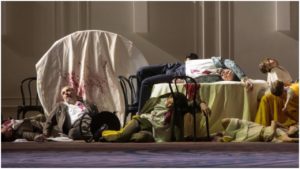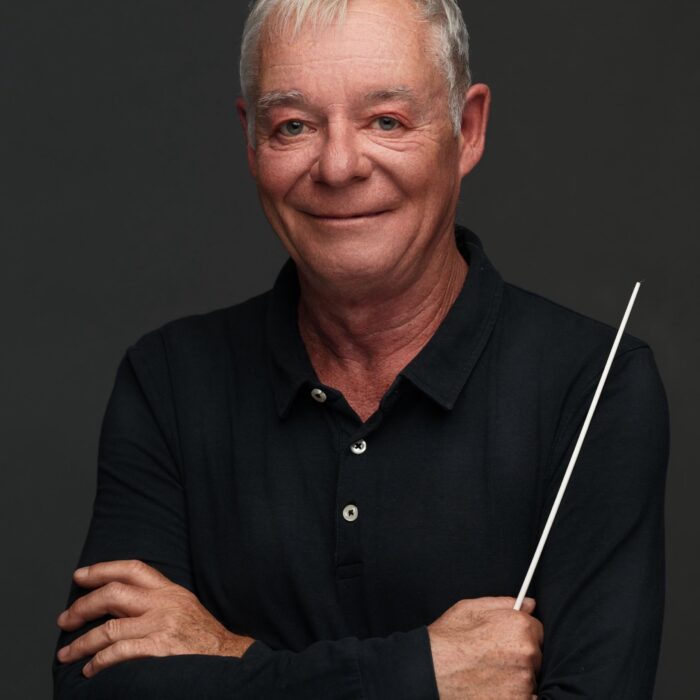
Teatro Di San Carlo 2018/19 Review: Ermione
A Disappointing Homecoming Despite Praiseworthy Performances From Angela Meade & Teresa Iervolino
By Alan Neilson(Photo: Luciano Romano)
Two hundred years ago Rossini’s tragic opera, “Ermione” was premiered at the Teatro San Carlo in Naples. Unfortunately, and uniquely it was the only one of the nine operas which he wrote for the city that met with complete failure. After five full performances and two performances of Act one it was shelved. It was not to see the light of day again until it received a concert performance in Siena in 1977. Now accepted as one of Rossini’s masterpieces, it is not clear as to why its initial reception was so negative, maybe it was the experimental nature of the work. It was unlikely to have been due to a weak cast or orchestra, for Naples was known for having a strong roster of singers and the finest orchestra in Italy. Whatever the reason, a failure it certainly was. Yet, Rossini seemed to retain belief in the work; he kept its manuscript until his death 1868, referring to it as his “Italian Guillaume Tell.” However, for the Teatro San Carlo’s final opera of the 2018-19 season it is once again opening up its doors to the work it had sought fit to withdraw two centuries ago.
Unfortunately, however, it was not given the best of performances, to the extent that one was left underwhelmed by the experience and slightly disappointed. The staging, the orchestra and the singing were all adequate, but taken as a whole it added up to a lackluster presentation; the sum being less than its parts!
Disjointed Production
The director for the production was Jacopo Spirei, whose underlying vision was sound. He wanted to delve deeply into the psychology of the characters, to expose the complexities of the human condition, and also that of Ermione herself, who unable to have Pirro, the man she wants, has him killed. She is not, however, presented as one dimensional bad person. Similarly, with the other characters, who are all faced with the same problem: they want something or someone they cannot have. Thus, Oreste, who wants Ermione is driven wild by her refusal, and is even prepared to kill for her, but again he is not portrayed as simply evil. After murdering Pirro, he quickly tries to blame Pilade for his deed, while Ermione is horrified and curses him for not understanding her true feelings. In an excellent ending, Spirei allows the murder scene to be revealed, in which we see bodies strewn everywhere, and it becomes clear that Oreste’s advisor, Pilade, in a state of mental torment, his shirt covered in blood, is also involved in the carnage. Such behavior is therefore not presented as a singular event, committed by a single person, but as an act which we all have the potential to carry out.
To this end, Spirei kept the focus on the principal singers, with little extraneous action or movement from the chorus or minor characters to distract. Unfortunately, this was not so successful, as it led to a fairly static presentation, which was not helped by the choreography which tended to cramp the chorus into the background.
The sets, designed by Nikalaus Webern, were deliberately claustrophobic, consisting for the most part of white walls and doors with no windows. The idea being to give the impression of forced containment in which human actions become more intense and extreme, like mice in cage. The effect, however, was also to create dull and insipid scenes, although with occasional exceptions such as the murder scene.
The costumes, designed by Giusi Giustino, were taken at random from fashions from across the centuries and had no recognizable sense to them, unless it was to suggest the timeless nature of the actions we were privy to. Nor were they particularly pleasing on the eye. On the positive side they did accord to the status and character of the person, so that Orestes was wearing a red and gold military uniform, Pirro a staid looking suit, with the chorus attired with costumes from antiquity.
Taken as a whole, it did not add up to much. Spirei’s good ideas did not translate very well onto the stage, and he was not aided by the sets or costumes, which lacked interest.
Uneven Music making
The musical direction was in the capable hands of Alessandro De Marchi. Normally so reliant, he failed to generate sufficient energy from the Orchestra del Teatro di San Carlo, who gave no more than a workmanlike performance, which in parts sounded too heavy. At times, there was also a lack of balance between the orchestral sections which led to a lack definition, and the overall effect did little to promote the onstage drama. De Marchi was, nevertheless, very attentive to the singers needs, possibly a little too much so in certain cases.
The Coro del Teatro San Carlo, under the management of Gea Garatti Ansini, similarly produced an uneven performance. At times it was in good voice, dramatically engaged with plenty of energy, yet at other times it was far too casual.
The role of Ermione is very demanding, requiring a soprano with excellent technique, versatility and the ability to infuse her singing with dramatic meaning. Angela Meade is such a soprano, and she put on a commanding display. It was the dramatic intensity with which she was able to infuse her singing which made her performance so powerful. Agility and intelligence alongside the raw power she can employ created a formidable, but not necessarily an always delicate performance. Every phrase was enriched with a variety of dynamic and a colorful accents, in which dark and light contrasts were used to promote expressiveness, and promote a psychological interpretation, although occasionally with a little too much vibrato. Her coloratura and trilling were finely rendered. Her voice resounded with quality, but while she was able weave a delicate filigree of sound at the upper end, the lower end was little hollow. Her acting was not always brilliant, but she more than compensated for this with her vocal characterization, in what was an excellent performance.
In the role of Andromaca was mezzo-soprano, Teresa Iervolino, who created a very impressive interpretation of a suffering mother who is willing to do almost anything to save her son. She produced a passionate and emotionally intense portrait, in which she colored her voice with a compelling expressivity. It is also an attractive and appealing voice, it is well-supported, strong across the range and projected clearly and articulately, which she used to spin out long engaging lines. Arias and ensemble pieces were wonderfully sung. Recitatives were delivered with nuance and strength, in which careful attention was paid to the meaning of the words and to the dramatic situation.
Pirro was initially to be performed by Enea Scala, but was later changed to John Osborn, and then Vladimir Dmitriuk. As it turned out, it was John Irvin who actually performed the role, and he really struggled to impose himself. The San Carlo is a large theatre, and Irvin’s voice is small, with poor projection and he often went missing, either lost in the ensembles or overwhelmed by the orchestra. When he could be heard, his singing displayed precision, but often at the expense of emotional depth, which had the unfortunate effect of sidelining him further. Although to be fair to Irvin, he did have some good moments. “Deh serena I mesti rai” is very lightly scored and allowed him to display his carefully crafted phrasing, underpinned by an attractive timbre.
Oreste was parted by the tenor, Antonino Siragusa. He gave a strong acting performance and produced a clearly defined portrayal. His high-lying tenor was perfect for the part, which he used with force and versatility, however his upper register sounded a bit throaty and its shine seems to have faded. Nevertheless, it was still a worthy performance, one which brought some necessary balance, given Irvin’s weakness, to Meade and Iervolino’s powerful vocal displays. His duet with Ermione, “Armati” was beautifully sung, the two voices combining sweetly, Meade’s voice compassionately echoing his words, having rejected him.
The minor roles all acquitted themselves well, although mezzo-soprano, Gaia Petrone, in the role of Cleone, Ermione’s servant, was particularly notable. She gave a self-possessed, confident account, in which the distinctive coloring of her lines impressed.
The tenor, Filippo Adami playing the role of Pilade, Oreste’s advisor and accomplice to mass murder, gave a strong acting performance, supported by a clearly articulated and crisp singing performance.
Fenicio, parted by baritone, Guido Loconsolo; Attalo by tenor Cristiano Olivieri and Cefisa by Chiara Trotta completed the cast, and all produced solid performances.
Maybe not the homecoming one would have wanted or expected for Rossini’s Neapolitan failure, but there were certain positives, none more so than the excellent contributions made by Angela Meade and Teresa Iervolino. And despite the negative aspects of the presentation, it succeeded in one important sense: it affirmed the quality of the work, which left one wondering why it was such a failure when it was originally premiered 200 years ago.
Categories
News


